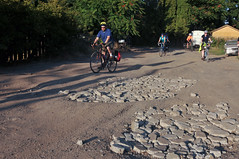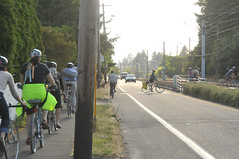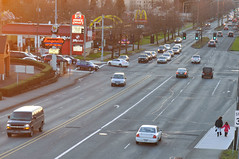
the report at a meeting last night.
(Photos © J. Maus)
The Portland Bureau of Transportation has released the public draft of their East Portland in Motion report, a five year strategy that sets a blueprint for improving biking and walking conditions in East Portland.
Work on the report has taken place over the past year through a variety of public meetings and surveys. The purpose, says a Bureau of Transportation (PBOT) statement, is to, “create a seamless network of accessible trails, sidewalks and bikeways that enable active transportation in the community.”
“I’m quite proud of the fact that we did a much different kind of process than PBOT normally does… to get a broad variety of inputs.”
— Ellen Vanderslice, PBOT
Far from just another plan with a wish list of projects that will never see the light of day, East Portland in Motion is an “implementation strategy.” It has funding behind it and the political urgency to get the projects on the ground immediately.
Last night at the PBOT Bicycle Advisory Committee meeting in City Hall, project manager Ellen Vanderslice shared the report. “We tried to take the known universe of projects already out there,” she explained, “and figure out what we can accomplish over the next five years, both with funding we already have and funding we expect to get.”
The backstory here is that East Portland residents have long accused City Hall of neglecting their needs. While the Central City gets all the attention and investment, residents complain, areas east of I-205 get very little (there’s a must-read in-depth story about this in the current edition of the Willamette Week).
But in recent years, PBOT has stepped up its efforts. The East Portland in Motion report is a testament to the renewed focus on the area. It also reflects lessons PBOT has learned in approaching communities who are skeptical of their intentions.
After getting burned by the SE Holgate buffered bike lane project, PBOT made sure to be very attuned to community perceptions this time around. Vanderslice told us last night that part of the East Portland in Motion process was to survey the community to learn more about their perspective on active transportation — before proposing any list of projects.
In their press release last week, PBOT wrote that they’ve come up with a set of projects that are not only feasible from an engineering and funding standpoint, but “are supported by the community” as well.
Taking a cue from the Community Cycling Center, PBOT enlisted experts from Portland State University to host group interviews with people who aren’t usually a part of the public process. “I’m quite proud of the fact that we did a much different kind of process than PBOT normally does… We heard from voice we don’t usually hear from… We spoke to Somalis, Ukrainian immigrants, and others, to get a broad variety of inputs,” said Vanderslice.
Vanderslice says those conversations yielded important feedback. “We learned lots of people don’t see bikes in their future.” In addition, Vanderslice says they also heard major support for access to transit and safe routes for kids to walk and bike to school. And, “no matter what their attitude was about biking,” she added, “they supported neighborhood greenways” (PBOT’s name for bike boulevards).
It makes sense to approach East Portland differently, because in many respects it’s like an entirely different city. The population in East Portland has a higher percentage of people living in poverty, it is more ethnically diverse, and it has been developed in a completely different way that other areas of Portland.
Vanderslice explained last night that the area grew quickly while it was still unincorporated. Instead of the grid network of small streets that are a legacy of Portland’s old “streetcar neighborhoods,” a lack of land-use planning east of I-205 has led to a landscape where major arterial streets dominate. Because of that, Vanderslice “It’s very difficult to find connections… It’s been an interesting challenge.”
Without connections or safe crossings, many people navigate around high-speed, high-volume arterial streets any way they can — often with tragic results. Projects identified in this report could vastly improve safety.
In total, the draft report calls for 20 sidewalk infill projects (there are many sidewalk gaps on major arterials), 56 crossing improvements on busy streets (56!), 10 neighborhood greenways, bike parking, and even a few bits of shared-use path. The major bike-centric projects include a north/south neighborhood greenway along the 130s and east/west greenways on Market, Mill, and Main Streets.

The big focus on neighborhood greenways is a key to East Portland’s active transportation future. They’re, “a scaffold,” says Vanderslice, “onto which the full buildout of future bikeways will occur.”
And here’s the good news. “All the lines on this map,” said Vanderslice, holding a map showing all the proposed projects, “should be doable in five years.”
Money for the plan comes from a mix of state gas tax revenue, federal grants, and PBOT’s traffic safety fund. When I asked Vanderslice for the total amount for all the projects, she said they aren’t giving out a lump sum number. The reason? After the PR debacle created by repeated misrepresentation of the “$600 million bike plan” by the media, that’s just another one of the lessons they’ve learned.
—
East Portland in Motion is in a public comment period until October 31st. Want to learn more? Take a bike tour of East Portland with some of the city’s transportation bigwigs, come to PBOT’s next Brown Bag discussion or check out the official project page.




